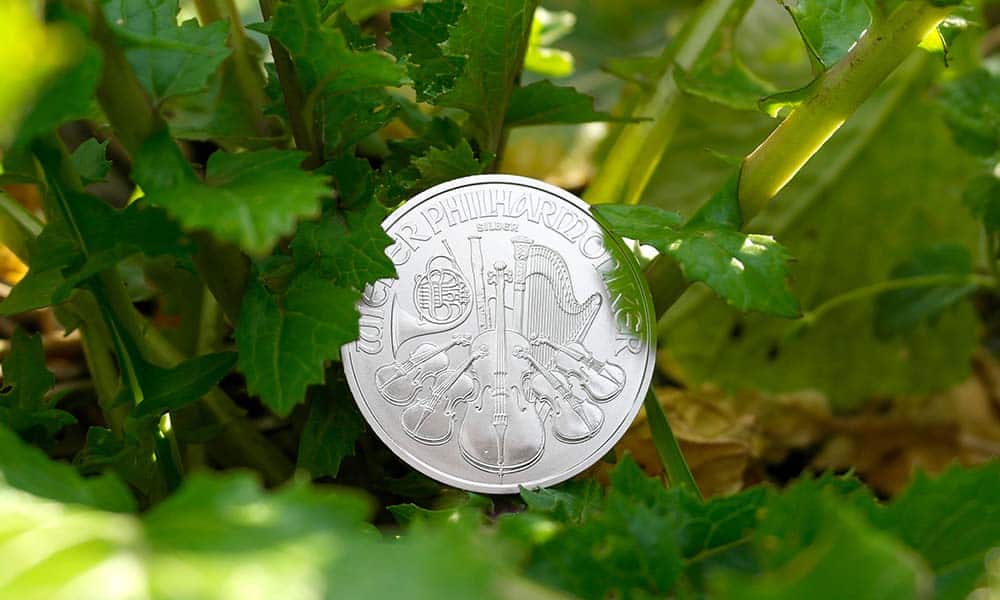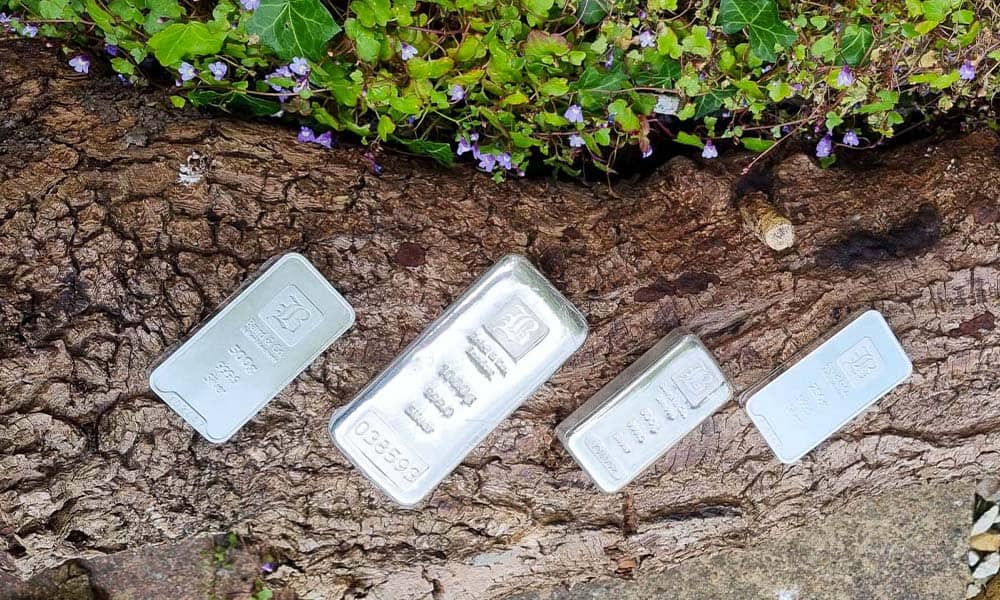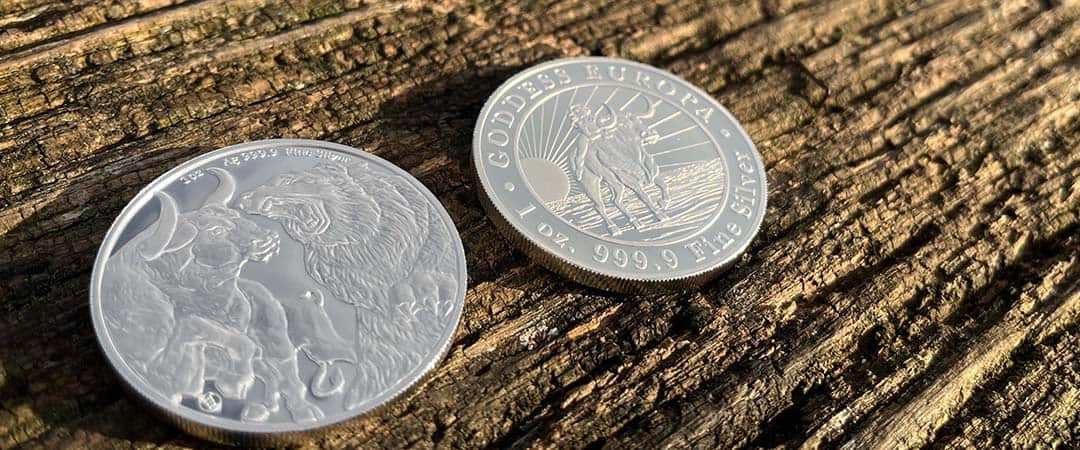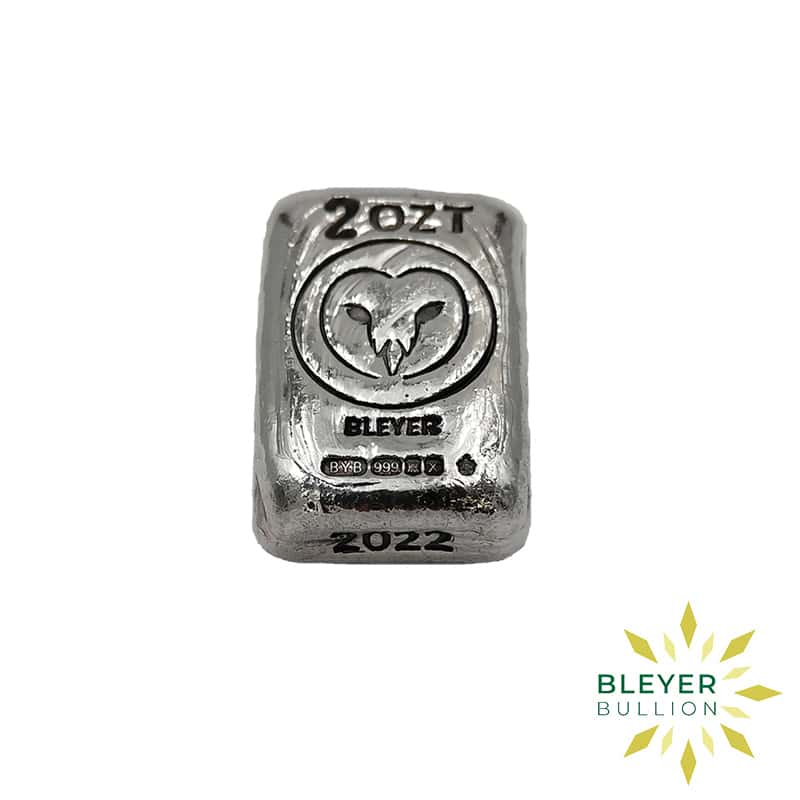At Bleyer, our goal is to make including silver in your investment portfolio as easy and accessible as possible. Before we get to the stage where you are buying physical silver, we want to make sure that investing in silver is the best investment decision for you.
This guide is designed to provide you with all the necessary information you will need to make that decision. We will cover what investing in silver actually means, what can affect the price of silver, the different options for you when you buy silver and the pros and cons of buying silver.

What is Silver Bullion?
Silver bullion is the term used for silver that is primarily bought as an investment and tends to be of a high purity. Silver bullion tends to be of a purity of 99.9% or higher and will be in the format of silver bars, rounds and coins. Items of silver that are not in these formats would not be considered to be bullion.
Silver is not as prestigious a precious metal as gold but it has many industrial uses and like gold has a long history of being used for currency. Silver first appeared as coinage around 600BC in the country now known as Turkey and was used around the world until the last century for this purpose.
What Are My Options if I Want to Buy Physical Silver?
While there are many different options when it comes to buying silver, it usually falls into two categories:
1. Silver coins
Silver coins are very collectable and are available in a wide variety of interesting and beautify designs. Coins, not to be confused with rounds, are produced (sometimes under licence) by government approved mints, such as the Royal Mint in the UK, the US Mint in USA, etc.
They are usually stamped with a face value in legal tender which easily differentiates them from rounds.
The market price of silver bullion coins varies with the value of the underlying metal and they are typically worth a lot more than the stated face value which of course represents a minimum value the coin can be exchanged for.
The purity of modern silver coins tends to be 99.9% or greater.
Silver coins are available in a range of sizes mainly measured in troy ounces. The most common weights of silver coins are 1oz, 2oz, 5oz, 10oz and 1Kg. It is also possible to buy ¼ and ½ oz coins but due to relatively high production and handling costs this is not a very cost effective way to buy silver.
2. Silver bars
The purity of silver bars tends to be 99.9% or higher.
Retail silver bars are commonly in sizes from 1g to 15 Kilo whereas LBMA Market Bars traded on the COMEX exchange are 1000 ounces. Silver bars are denominated in either troy ounces or grams and kilos.
It is not cost effective to produce tiny bars so the smallest tend to be 1oz. It is however possible to buy combi bars that can be broken up into single grams or fractional ounces.
Coins vs Bars
Silver legal tender coins such as Britannias and other coins produced by the Royal Mint are Capital Gains Tax exempt and although bars are generally a cheaper way to buy silver, bulk discounts help with buying larger quantities of silver coins such as ‘Monster’ boxes.
Coins may also have numismatic value for those interested in collecting different years, with varying designs, rarity and other qualities.
Larger bars are generally more cost effective than buying quantities of silver coins due to lower production and handling costs. Therefore, if you can manage the CGT allowance effectively, bars represent better value for money.
What can affect the silver price?
As with any investment, the price of silver can vary – just like the stock markets. In order to decide whether investing in silver is the best use of your money, it is important to know what can affect the silver market. As with almost everything, it largely comes down to supply and demand. So we should consider what the drivers are.
Central banks, major investors and large financial institutions all over the world will hold reserves of silver in physical and paper formats. Whilst still significant, silver tends to be less important than gold for investment purposes as it has many practical and industrial uses.
Silver applications are far reaching with many industrial and household uses such as in solar panels, engine components, LED screens, medical uses and for food preservation. According to a Metals Focus report in 2021 some of the statistics for total world demand were as follows: Coins and Bars 26.5%, Jewellery 17.3%, Industrial 48.5%.
Silver tends to move in a similar direction to gold, although often lagging and moves are generally more dramatic. Whilst gold surpassed its high of 2011 a long time ago, silver is yet to come close.
It is generally believed that the true price of silver should be much higher than we are seeing now. In May 2022 the ratio was 85:1 whereas ten previously it was 55:1.
With silver being of greater significance in industry to investment we would expect this to be a more influential driver.

The Pros and Cons of investing in silver
With this in mind, let’s take a quick look at some of the pros and cons of investing in silver, to help you make the best possible investment decisions for you and your family.
Pros of investing in silver
- Diversification: Silver can be used to diversify your portfolio and since the price is relatively low you get a lot more metal for your money when you buy silver, over other precious metals.
- Tax efficient: Legal tender coins in your own country are exempt from Capital Gains Tax. Silver can be bought outside the tax system to avoid having to pay VAT.
- Stability: Silver is not as stable as gold in terms of price fluctuation but as a commodity it will always retain a percentage of its value and coins will never fall below their face value.
- Control: Your silver is something physical – not just numbers on a spreadsheet. You don’t have to trust a fund manager to look after it for you, you can physically store it in your own home. When it comes to buying and selling silver, you are in complete control.
- Many industrial uses: With silver being an industrial metal too it has the potential to hold its price and do well when the economy is booming and producing products that use this metal.
- Accessible: With a lower price entry point almost anyone can afford to invest in this metal. You don’t have to have as much valued tied in single pieces either.
- Wide range of products: Many are so reasonably priced that they make stunning everyday gifts.
- Strong history of use as currency: Silver has been used as in currency more often than gold and many of our customers buy silver with this in mind. It is easier to imagine using silver as a useful everyday exchange mechanism than it is for gold.
Cons of investing in silver
- Storage: Silver is bulkier and more costly to store and ship than the equivalent value of gold or other precious metals.
- VAT: Unless stored offshore or in a bonded warehouse VAT is payable on all silver bars and coins.
- No interest or dividends: No regular pay-outs, so to cash in you will need to sell some of your silver.
- Higher premiums: The cost of processing is by weight and volume, not value, (i.e. 1oz of silver costs the same to mint as 1oz of gold, yet the value of the raw silver itself is 85 times less. This causes the retail markup to be higher as a percentage.

Verdict
Silver is suitable for a range of investors, whether this is the only metal you’re considering or not, its lower price entry point makes it a popular choice for many. Since higher premiums make it harder to profit in the short term, we rate this as a long term buy and hold. It is considered by many that the silver price is suppressed and that it has great potential to soar. Whilst this may be the case, it is impossible to say how long this situation will prevail.
It is not our job to tell you that you should invest in silver or anything else for that matter. Every investment carries a degree of risk, however through diversification you can reduce the overall risk in your portfolio. You will need to do some of your own, independent research and have a think about what you want to get out of your investment before you can decide. It is your money and your decision.
What we can do is make it as easy as possible if you decide that you want to invest in silver, and walk you through the process – offering our expertise and listening to you. You will always have control over your own investments when you work with us.
If you have any questions at all about investing in silver, now is the time to get in touch with us. We will offer you our insight and answer any questions you have so that you can make the right decisions for you and your money.
















